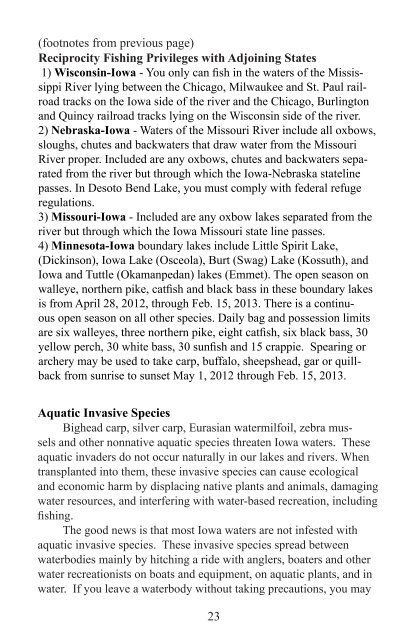DNR Fishing Regulations 2012 - Marshall County
DNR Fishing Regulations 2012 - Marshall County
DNR Fishing Regulations 2012 - Marshall County
Create successful ePaper yourself
Turn your PDF publications into a flip-book with our unique Google optimized e-Paper software.
(footnotes from previous page)<br />
Reciprocity <strong>Fishing</strong> Privileges with Adjoining States<br />
) Wisconsin-Iowa - You only can fish in the waters of the Mississippi<br />
River lying between the Chicago, Milwaukee and St. Paul railroad<br />
tracks on the Iowa side of the river and the Chicago, Burlington<br />
and Quincy railroad tracks lying on the Wisconsin side of the river.<br />
) Nebraska-Iowa - Waters of the Missouri River include all oxbows,<br />
sloughs, chutes and backwaters that draw water from the Missouri<br />
River proper. Included are any oxbows, chutes and backwaters separated<br />
from the river but through which the Iowa-Nebraska stateline<br />
passes. In Desoto Bend Lake, you must comply with federal refuge<br />
regulations.<br />
3) Missouri-Iowa - Included are any oxbow lakes separated from the<br />
river but through which the Iowa Missouri state line passes.<br />
4) Minnesota-Iowa boundary lakes include Little Spirit Lake,<br />
(Dickinson), Iowa Lake (Osceola), Burt (Swag) Lake (Kossuth), and<br />
Iowa and Tuttle (Okamanpedan) lakes (Emmet). The open season on<br />
walleye, northern pike, catfish and black bass in these boundary lakes<br />
is from April 8, 0 , through Feb. 5, 0 3. There is a continuous<br />
open season on all other species. Daily bag and possession limits<br />
are six walleyes, three northern pike, eight catfish, six black bass, 30<br />
yellow perch, 30 white bass, 30 sunfish and 15 crappie. Spearing or<br />
archery may be used to take carp, buffalo, sheepshead, gar or quillback<br />
from sunrise to sunset May , 0 through Feb. 5, 0 3.<br />
Aquatic Invasive Species<br />
Bighead carp, silver carp, Eurasian watermilfoil, zebra mussels<br />
and other nonnative aquatic species threaten Iowa waters. These<br />
aquatic invaders do not occur naturally in our lakes and rivers. When<br />
transplanted into them, these invasive species can cause ecological<br />
and economic harm by displacing native plants and animals, damaging<br />
water resources, and interfering with water-based recreation, including<br />
fishing.<br />
The good news is that most Iowa waters are not infested with<br />
aquatic invasive species. These invasive species spread between<br />
waterbodies mainly by hitching a ride with anglers, boaters and other<br />
water recreationists on boats and equipment, on aquatic plants, and in<br />
water. If you leave a waterbody without taking precautions, you may<br />
3


